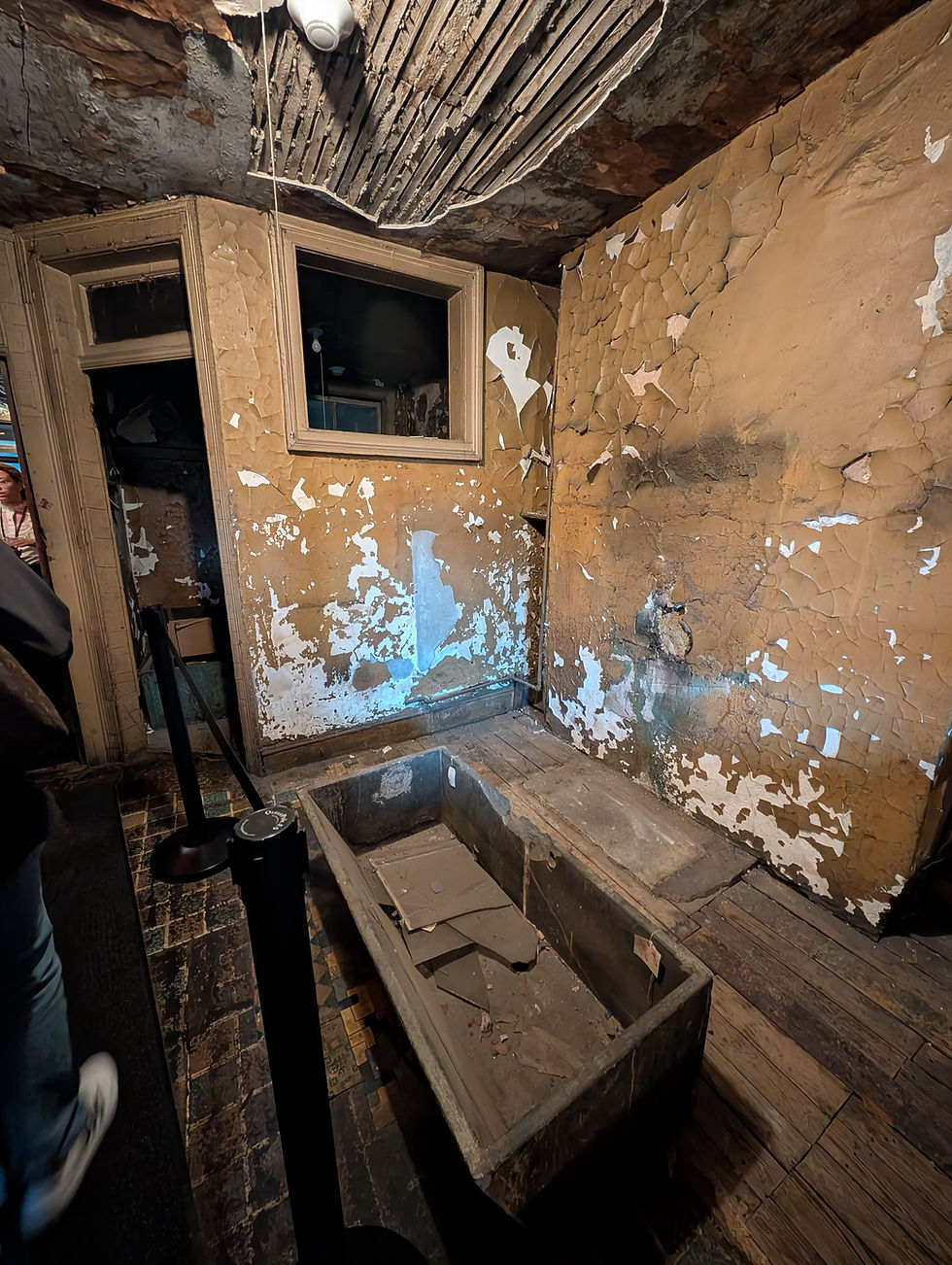Toilets and the US Immigrant Experience
- Kimberly Worsham
- May 16
- 4 min read
What if you moved to a new country and your entire apartment building shared one toilet—and it was outside?
When visiting New York City's Tenement Museum, our Founder was drawn to a critical aspect of immigrant life that's often overlooked: sanitation. How did early urban immigrants in the US handle something as fundamental as going to the bathroom? This blog will explore some of the important history in the US, specifically, how immigrants navigated urban life.

About The Tenement Museum
The Tenement Museum is a world-renowned institution established in 1988 at 97 Orchard Street. The museum preserves and presents the history of American immigration and urban working-class life. It highlights the real-world conditions in which people lived and shares the evolution of housing for immigrants in the 19th and 20th centuries.
In many ways, the museum explores themes that resonate with the immigrant journeys of people across the country. It employs empathy and dialogue to tell stories about people in the US who are often excluded from its history books. One feature of these early living stories was their sanitation experiences.
Images of inside the Tenement Museum (Credit: FLUSH/K Worsham)
Sanitation Realities in Early Tenements
Early tenements didn't have indoor toilets; instead, they had outdoor privies or outhouses. Sometimes those were connected to sewer or drainage systems, and sometimes they weren't. The privies at 97 Orchard Street were advanced for their time, as the Tenement Museum's old outhouses did connect to the sewer system, which was a selling point, because people didn't have to empty them. By the early 20th century, the building housed many residents who shared just a few outdoor privies and a single water spigot in the rear yard.
Water was collected at the bottom of the house, near the outhouses, and had to be carried up to the top, which, if you ever had to lug a water jug, you know – it’s heavy. This simple fact shaped daily routines for residents, who had to transport water up several flights of stairs for cooking, cleaning, and bathing.
Pictures of the outhouse/privy and water spigot at the Tenement Museum - both at ground level and four flights up (Credit: FLUSH/K Worsham)
The Tenement Museum investigated its rear yard space and made a fascinating discovery. Archaeologist Dr. Joan Geismar excavated the rear yard, expecting to find evidence of a standard privy vault—essentially a stone-lined pit for holding human waste that would require regular emptying. Instead, they discovered something more sophisticated: a brick-lined vault connected to the sewer system. This discovery revealed that the landlord had installed a more advanced waste system with sewer connections, and clean water represents an additional cost that not all landlords were willing to invest in.
When using the outdoor privies wasn't practical, residents relied on alternative solutions. Chamber pots were often used, which would be ideally brought down the stairs and emptied into the outhouse. Later, the chamber pots would be placed under the bed—a habit possibly adopted by Irish immigrants from the old country and potentially referred to as a guzunder, like the British did. This practical solution was essential, especially at night or during inclement weather when visiting the outdoor facilities would have been difficult.
However, it is unknown whether all residents safely disposed of their contents in the outhouse and did not throw them out of the windows.

The Push for Sanitation Reform
Why might a landlord have made a significant investment in sanitation at the time? Historical context can give us some clues. Cholera, for example, was primarily a waterborne disease, but people initially believed it was caused by contaminated air until we eventually realized it was a problem with contaminated water. Indoor flush toilets first appeared in wealthy homes in New York City in the 1860s, while the rest of the city continued to use chamber pots and privies.
The 1860s witnessed significant reforms emerging in New York, including establishing the Citizens Association Council on Hygiene and Public Health in 1865, which aimed to enhance street cleanliness and improve housing conditions to mitigate cholera-related issues. These reforms helped establish standards for improved sanitation in tenement buildings. The 1867 Tenement Housing Act also mandated the provision of sufficient privies, drainage, and sewer connections. But that didn't always happen - the working class continued to use chamber pots and outdoor toilets, or outhouses, even deeper into the 20th century.
Sanitation Beyond Plumbing
Sanitation issues extended beyond the toilet. Trash was also a significant issue in New York City at the time. There were no garbage trucks, and people dumped things on the street, including animal carcasses, food scraps, and broken furniture. The city gutters were pretty rife with gross garbage just piling up. This made things smell gross…and crawling with disease.

The tenement buildings also struggled with pest problems. They were infested with rodents that would enter and cause damage, gnawing on the walls and nibbling on food scraps. People would try to get rid of these rodents with poisons, but didn't always realize that said poisons were also toxic to them.
Reflections on Modern US Privilege
The public privy wasn't just a bathroom facility but a nexus of public health, immigration policy, class distinctions, and daily survival. It reminds us that basic human needs often reveal the most profound social truths. The privies of 97 Orchard Street stand as quiet monuments to human necessity, progress, and the distance we still have to travel to ensure everyone has access to a safe toilet.
Immigrant populations in the US – probably millions – are still disproportionately struggling to get clean access to water and safe toilet systems. These ongoing disparities underscore the need for continued advocacy and investment to ensure equitable access to these basic human rights.
Next time you visit the Tenement Museum, take a moment in that recreated rear yard. Look at those four wooden doors with their half-moon cutouts, and imagine the daily parade of residents—German, Irish, Jewish, Italian—all sharing this most basic of human experiences. All are participating in a humble but essential ritual of survival in their new American home.











Comments